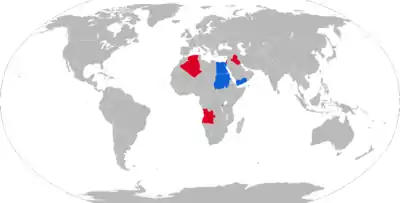Walid (armored personnel carrier)
The Walid is an Egyptian wheeled armored personnel carrier based on the BTR-40. It was built by the Kader Factory for Developed Industries.[1] It entered production in 1960 and was first deployed by the Egyptian Army during the Six-Day War.[2]

History
In the early 1960s, Egypt began to reproduce and reverse engineer a number of Soviet weapons designs.[2] The Walid marked one of Egypt's first attempts at reproducing or adapting Soviet military hardware using Western technology.[3] It was designed by civilian engineers at a Nasr Automotive facility in Helwan[4] and modeled directly on the BTR-40, an early postwar Soviet wheeled APC.[3] The Walid combined the hull designs of the BTR-40 and its larger successor, the BTR-152, with the chassis of a 4X4 Magirus utility truck manufactured under license by the Kader Factory.[2] The sides of the Walid's hull were also sloped, unlike the flat sides of the BTR-40's hull, for improved ballistic protection.[2] Production of the Walid continued with very little variation to the original design until 1981, when Kader began manufacturing the vehicle chassis with slightly different Mercedes-Benz automotive components.[2]
Egypt deployed the Walid during the Six-Day War.[2] Small numbers were captured and pressed into service by the Israel Defense Forces (IDF) in the wake of that conflict.[5] The Walid was replaced in front-line service with the Egyptian Army by the Kader Fahd during the 1980s.[2] However, it continued to see active service with various paramilitary divisions of the Egyptian Ministry of Interior.[6]
Description
The vehicle consists of a German Magirus or Mercedes-Benz truck chassis with an Egyptian-built armored hull. The body was open-topped but fully enclosed versions were available. The open top versions have a canvas cover. The commander has a weapon mount, and others can be positioned along the edges of the roof along the hull sides and rear. The hull has a door on each side of the cab and one door in the rear of the hull. There are also three firing ports on each side of the hull. The Walid has no NBC or night vision system.
Variants
Command Vehicle - basic APC but with extra radios
Self-propelled wheeled multiple-rocket launcher manned by a crew of two and armed with either six or twelve 80 mm rocket-launcher tubes (depending upon model).
Users
The Walid has been supplied to Burundi, Iraq, Sudan, and Yemen where it was mostly used for internal security and riot control.
Israel captured some and used them for border security. At least one was seized from Angola by the South African Defence Force during Operation Savannah.[7]
In popular culture
In the 1960s and 1970s, the Walid was used several times in war movies shot in the Egyptian desert, appearing as a fake armored truck of the Afrika Korps with a German Balkenkreuz painted on the side.
Operators

Current operators
Former operators
 Angola - Aid; undisclosed number saw service during the Angolan Civil War.[7]
Angola - Aid; undisclosed number saw service during the Angolan Civil War.[7] Algeria – 20 delivered in 1978.[8]
Algeria – 20 delivered in 1978.[8] Israel - Captured from Egypt.[10]
Israel - Captured from Egypt.[10] Iraq – 100 were ordered in 1979 and delivered in 1980.[8]
Iraq – 100 were ordered in 1979 and delivered in 1980.[8] North Yemen - 20 were ordered in 1974 and delivered in 1975.[8]
North Yemen - 20 were ordered in 1974 and delivered in 1975.[8] Palestine Liberation Organization - Aid.[10]
Palestine Liberation Organization - Aid.[10]
Specifications
- Configuration: 4 x 4
- Manufacturer: AOI Kader Factory, Cairo, Egypt
- Crew: 2 + 10
- Armament: 1 x 7.62 mm PKM MG
- Ammunition: 1,000 x 7.62 mm
- Length: 6.12 m
- Width: 2.57 m
- Height: 2.3 m
- Ground Clearance: 0.4 m
- Weight (Combat): 12,000 kg
- Weight (Empty): 9,200 kg
- Power-to-weight ratio: 14 hp/t
- Engine: 168 hp Deutz AG diesel
- Maximum Road Speed: 86 km/h
- Maximum Range: 800 km
- Fording: 0.8 m
- Vertical slope: 0.5 m
- Gradient: 60%
- Side Slope: 30%
- Armour: 8 mm steel
References
- "Walid Specifications". GlobalSecurity.org. GlobalSecurity.org. Retrieved 21 May 2021.
- Christopher F. Foss (2001). Jane's Armour and Artillery (2002 ed.). Macdonald and Jane's Publishers Ltd. p. 446. ISBN 978-0710623096.
- McDermott, Jacques (1988). Egypt from Nasser to Mubarak: A Flawed Revolution, Volume Three. Abingdon, Oxon: Routledge. p. 172. ISBN 978-1135091156.
- Brzoska, Michael; Ohlson, Thomas (1986). Arms Production in the Third World. London: Taylor & Francis. p. 116. ISBN 978-0850663419.
- Cordesman, Anthony (October 2016). After The Storm: The Changing Military Balance in the Middle East. London: Bloomsbury Publishing. pp. 112–124, 701. ISBN 978-1-4742-9256-6.
- Cordesman, Anthony (30 September 2004). The Military Balance in the Middle East. Westport: Praeger. p. 186. ISBN 978-0275983994.
- [webspace.webring.com/people/qs/sa_bushwar1/opssavannah.html Op Savannah]
- "Trade Registers". Armstrade.sipri.org. Retrieved 2013-06-20.
- Christopher F. Foss (2000). Jane's Tanks and Combat Vehicles Recognition Guide (2000 ed.). Harper Collins Publishers. p. 252. ISBN 978-0004724522.
- Christopher F. Foss (1976). Jane's World Armoured Fighting Vehicles (1976 ed.). Macdonald and Jane's Publishers Ltd. p. 204. ISBN 0-354-010220.
Bibliography
- Christopher F. Foss, Jane's Tank and Combat Vehicle Recognition Guide, HarperCollins Publishers, London 2002. ISBN 0-00-712759-6